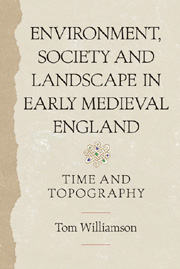Book contents
- Frontmatter
- Contents
- List of Illustrations
- Acknowledgements
- Introduction
- 1 Settlement and Society
- 2 Nature's Frame
- 3 Culture, Ethnicity and Topography
- 4 Small Shires, Deep Roots
- 5 The Gradient of Freedom
- 6 Two Countrysides?
- 7 Village, Farm and Field
- 8 Landscape and Settlement
- 9 Woodland and Pasture
- Conclusion: Time and Topography
- Bibliography
- Index
- ANGLO-SAXON STUDIES
Conclusion: Time and Topography
Published online by Cambridge University Press: 05 April 2013
- Frontmatter
- Contents
- List of Illustrations
- Acknowledgements
- Introduction
- 1 Settlement and Society
- 2 Nature's Frame
- 3 Culture, Ethnicity and Topography
- 4 Small Shires, Deep Roots
- 5 The Gradient of Freedom
- 6 Two Countrysides?
- 7 Village, Farm and Field
- 8 Landscape and Settlement
- 9 Woodland and Pasture
- Conclusion: Time and Topography
- Bibliography
- Index
- ANGLO-SAXON STUDIES
Summary
Throughout the course of this book I have argued that patterns of regional variation in early-medieval England were largely a function of environmental factors: of climate, topography, geology and soils. Although this is an unfashionable suggestion, the hidden hand of nature does appear to be implicated in many of the distributions studied by landscape historians, historical geographers, archaeologists and others; and by examining particular social and cultural patterns within their environmental contexts we can often, as I have suggested, contribute significantly to an understanding of their true significance.
I have thus argued that spatial variations in the character of the Anglo-Saxon settlement, as indicated by the distribution of different kinds of artefacts and burial practices in the fifth and sixth centuries, were associated with broad topographic zones, corresponding to major drainage basins and defined by the watersheds between them. This, I further suggested, implies that whatever the precise scale of immigration from the continental mainland in this period the cultural character of different regions of early England was forged largely by emulation, as local communities assumed fashions and identities to which they were most regularly exposed. The patterns exhibited by material culture, that is, do not simply mirror the historical events imperfectly presented in our documentary sources: they do not result from either the random patterns of conquest effected by a military elite, or the chance choices of territories within which to settle made by those involved in a folk movement.
- Type
- Chapter
- Information
- Environment, Society and Landscape in Early Medieval EnglandTime and Topography, pp. 234 - 246Publisher: Boydell & BrewerPrint publication year: 2012



